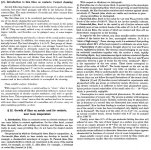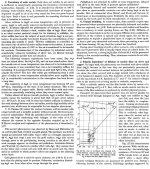Try this, http://www.cotorelay.com/datasheets/Coto Technology 3500 Reed Relay.pdf
They work fine at 50nV and sub-picoamp currents by experience at the 10e7 uses level.
Nice looking relay. I usually use Panasonic AG series - but they are not as good as these.
I would suspect that as long as the relay is completely sealed (i.e. Airtight) and filled with inert gas you would be ok. Further, the wiping action of the contacts of course is fundamental to ensuring they stay clean.
I'll give you a hint at 50 volts into 10 ohms Ohm's law would predict 5 amps. Try it and the correct answer is the steady state will be zero amps.
My bad. I tried 5 amps into 30 gauge and it didn't blow!
I suspect the result will be a damaged power supply!
Well which is it? First and second choices are mutually exclusive. I have 0-100V 1000W power supplies so the third is unlikely. It’s not just me George is also confused. Again you leave us and don’t give us a lead on your reasoning, certainly 50V on 10 Ohms of 10 AWG wire is no problem.
George, Contrary to Scott's assertions, there really are very interesting effects in signal transport through audio cables when there are very low currents. It results in charge interaction between the signal and conductor remaining, but virtually no charge interaction between information carrying charges. So although the total charge transfer remains constant information is lost.
I’m with George that paragraph is very cryptic, at a casual level it might be seen as another invocation of Maxwell’s Demon. Lost information is known as noise, review Shannon’s work on information capacity of a noisy channel. My assertions are simply a restatement of the last few decades of engineering knowledge, dismissing it without proof is an extraordinary claim.
Again simply challenging your claims is taken as a personal attack or an “annoyance”, back them up.
I thought we put the micro-diodes and solder joints to bed a long time ago, I would like to add that there is no insulating gap (vacuum or gas) between conductors that has a 100mV or even 1V breakdown, Pashen’s law.
Nice looking relay. I usually use Panasonic AG series - but they are not as good as these.
I would suspect that as long as the relay is completely sealed (i.e. Airtight) and filled with inert gas you would be ok. Further, the wiping action of the contacts of course is fundamental to ensuring they stay clean.
I have to take back the cheap, these might push the $40 range in onesies like the Teledyne RF relays.
The issue is that measuring gear, and audio systems, work and are used in very different ways. The former are switched on, clicked to appropriate settings, transients pass through the gear from all the fiddling, if a reading doesn't make sense the instinctive response is to activate the various related switches - the glitch clears, and 5 minutes later the gear is put away until the next time it's used. Now, take one of these testing devices, put it in a place where it can't be interacted with, and have it in a sleep mode where it nothing happens until a trigger signal of say 1uA, travelling across a relay, is detected. How much money would people put down that there is 100% certainty of correct behaviour after 6 months, say?
I have done the exercise in the replay chain many times - once heard, the difference makes not doing so a rather poor decision,Perhaps I just haven't been shown the difference if the switches had been removed from the chain, but I just think about all the switches, sliders and interconnects in record production and PA applications and it would seem that this would really amplify the problem by a factor due to the number of these problems.
The issue is that measuring gear, and audio systems, work and are used in very different ways. The former are switched on, clicked to appropriate settings, transients pass through the gear from all the fiddling, if a reading doesn't make sense the instinctive response is to activate the various related switches - the glitch clears, and 5 minutes later the gear is put away until the next time it's used. Now, take one of these testing devices, put it in a place where it can't be interacted with, and have it in a sleep mode where it nothing happens until a trigger signal of say 1uA, travelling across a relay, is detected. How much money would people put down that there is 100% certainty of correct behaviour after 6 months, say?
IOW, if the relay contacts isn't cleaned by a wiping action over a significant period of time, and has no current passing through it in the interim - then from that 'cold start' is it going to work in passing a low level of current, or not ... ?
Relay contacts in an inert atmosphere do not need cleaning, the are no mechanisms to oxidize the surface, this is well known.
Frank,
I could be wrong but it seems you are mixing two different functions here. The fact that a hermetically sealed relay will not oxidize and passing current below the rated minimum value. I'll let Scott answer that part but this does seem to be two different issues.
I could be wrong but it seems you are mixing two different functions here. The fact that a hermetically sealed relay will not oxidize and passing current below the rated minimum value. I'll let Scott answer that part but this does seem to be two different issues.
Kinderhorn, my concern is with reliability - if the relay is left undisturbed for long periods in a closed state will the contact resistance remain stable? Everything I read over several rounds of looking at this makes me very suspicious, the manufacturers certainly don't spell it out - corrosion in contacts happens for a myriad of reasons, atmospheric exposure is only one of them - and several writers very explicitly state that sealed relays should not be trusted to behave.
Anyway, of possible interest to some, in my researching about relay reliability I came across this, http://indico.cern.ch/event/274193/material/slides/1?contribId=0 , STUDY IN ELECTROMECHANICAL
RELAYS RELIABILITY - it looks at other factors than those relevant to audio, though ...
Anyway, of possible interest to some, in my researching about relay reliability I came across this, http://indico.cern.ch/event/274193/material/slides/1?contribId=0 , STUDY IN ELECTROMECHANICAL
RELAYS RELIABILITY - it looks at other factors than those relevant to audio, though ...
Last edited:
I would hope the relays in weapon systems aren't as flaky as you are suggesting.
The relays in my Shibasoku analyzer seem to be good for -140 dB THD into 1 MOhm at 1V with no issues and they are 20+ years old. It sees service very like an audio system. Sit for a while, even weeks or years and then get fired up and work perfectly.
How do you compare components like relays? The process of changing/comparing may address other issues you aren't aware of. The old classic example was the oil additive that improved mileage. Done properly with a tune-up it always made a difference. Funny how the tune up alone would make a difference anyway, but was never mentioned.
The relays in my Shibasoku analyzer seem to be good for -140 dB THD into 1 MOhm at 1V with no issues and they are 20+ years old. It sees service very like an audio system. Sit for a while, even weeks or years and then get fired up and work perfectly.
How do you compare components like relays? The process of changing/comparing may address other issues you aren't aware of. The old classic example was the oil additive that improved mileage. Done properly with a tune-up it always made a difference. Funny how the tune up alone would make a difference anyway, but was never mentioned.
Try this, http://www.cotorelay.com/datasheets/Coto Technology 3500 Reed Relay.pdf
They work fine at 50nV and sub-picoamp currents by experience at the 10e7 uses level.
I think this datasheet is not complete, the range of switched currents is not indicated. The unique feature of Coto is nV-range of the thermal emf.
One of the best Panasonic relays for low-signal applications is the following:
"This relay will be used for the small load for measuring instruments or others where a stable contact resistance is required." The low limit of switched currents indicated for this relay is 10uA and 1mV. By indicating this, I guess, manufacturer says, that if one uses relay at 1uA - errors and distortions are expected.
There exist, no doubt, relays better than this, but maybe they are rarely used for audio, due to price limitations. And, more important, to remember that RCA connectors are not vacuum sealed in glass tubes, as well as rotary switches.
Attachments
Last edited:
Relay contacts in an inert atmosphere do not need cleaning, the are no mechanisms to oxidize the surface, this is well known.
I did some copy and paste from R. Holm’s book
George
P.S. If you go through the book, you will notice that although there are many protagonists at play, the humblest -these of mechanical nature- are the most influential.
Attachments
The issue is that measuring gear, and audio systems, work and are used in very different ways. The former are switched on, clicked to appropriate settings, transients pass through the gear from all the fiddling, if a reading doesn't make sense the instinctive response is to activate the various related switches - the glitch clears, and 5 minutes later the gear is put away until the next time it's used. Now, take one of these testing devices, put it in a place where it can't be interacted with, and have it in a sleep mode where it nothing happens until a trigger signal of say 1uA, travelling across a relay, is detected. How much money would people put down that there is 100% certainty of correct behaviour after 6 months, say?

do you ever wonder how high reliability stuff is designed, made and tested, stuff where failure or a little mistake is not some Audio nut perceiving some problem with the sound, but could put life at risk!
So, a normally closed, sealed relay will always pass current below its rated minimum, in all circumstances, irrespective of the period since it was last operated?
RE: my last post.
relays for low-signal applications
3 decades ago (with loads more pictures) : www.uni-kl.de/elektronik-lager/447105
Blanket statement, cant give a blanket answer, so many factors to consider...
but for a correctly design circuit with the correct type of relay, yes...
One wonders that if some Audio fanatics spent as much time researching and learning about real engineering solutions as they spend chasing demons whether their systems would improve? Sometimes they do seam to get stuck discussing the quality of the weave in the Emperors New Clothes.
(pun intended)
but for a correctly design circuit with the correct type of relay, yes...
One wonders that if some Audio fanatics spent as much time researching and learning about real engineering solutions as they spend chasing demons whether their systems would improve? Sometimes they do seam to get stuck discussing the quality of the weave in the Emperors New Clothes.
(pun intended)
Last edited:
Still haven't got an answer: will it or won't it pass the current?
Look mercury wetted reed relays do not have a minimum current. I have used them at 20fA with 10e12 Ohm resistances. They are used in ATE equipment by the 100's of 1000's all of which would fail otherwise.
- Status
- Not open for further replies.
- Home
- Member Areas
- The Lounge
- John Curl's Blowtorch preamplifier part II

